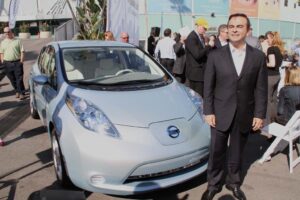
2011 Chevy Cruze
One has to wonder why it is taking GM so long to bring this vehicle to North America? In today's economy, this is a car that makes perfect sense and should immediately find a receptive market. Maybe that is wy they are taking so long....it just makes good sense!
From Green Car Congress:
GM unveils the US production version of the 2011 Chevrolet Cruze compact sedan at the LA Auto Show on 2 December. The Cruze will compete with vehicles such as Toyota Corolla; Honda Civic; Ford Focus; Hyundai Elantra; and Nissan Sentra.
The Cruze is a GM global car; the North American version features a new Ecotec 1.4L I-4 turbo with variable valve timing that delivers up to an estimated 40 mpg (EPA ratings pending) on the highway with a high-efficiency model. GM has already introduced the Cruze in Europe and Asia.
Cruze goes on sale in the US in the third quarter of 2010 but has already logged more than 4 million miles in quality and durability testing worldwide, making it one of the most real world-tested GM products prior to a US launch. The US and Canadian versions of the Cruze will be built in Lordstown, Ohio, where US$350 million was invested for their production.
The 2011 Chevrolet Cruze will be offered in LS, LT and LTZ trims. The models will feature a new family of efficient four-cylinder engines, including a 1.4L turbo and 1.8L unit, coupled with six-speed automatic and manual transmissions. Electric power steering is standard.
Enhanced with its exhaust-driven turbocharger, the Cruze’s Ecotec 1.4L turbo performs like a larger engine when needed, but retains the efficiency of a small-displacement four-cylinder in most driving conditions. It is standard on LT and LTZ models, with power ratings estimated at 138 horsepower (103 kW) and 148 lb-ft of torque (200 N·m).
Standard on LS models is an Ecotec 1.8L four-cylinder that has the same basic architecture as the 1.4L turbo. Both engines are part of GM’s family of global small-displacement engines designed with fuel efficiency in mind, including technology such as full variable valve timing that optimizes performance and fuel economy across the rpm band.
With the Ecotec 1.4L turbo, Cruze’s fuel efficiency enables a cruising range of more than 500 miles (800 km).
| Engines for the 2011 Cruze | ||||||
|---|---|---|---|---|---|---|
| 1.8L DOHC I-4 | 1.4L turbocharged DOHC I-4 | |||||
| Displacement (cu. in. / cc): | 110 / 1796 | 83.2 / 1364 | ||||
| Bore and stroke (in. / mm): | 3.17 x 3.47 / 80.5 x 88.2 | 2.85 x 3.25 / 72.5 x 82.6 | ||||
| Block material | cast iron | cast iron | ||||
| Cylinder head material: | cast aluminum | cast aluminum | ||||
| Valvetrain | overhead camshafts, four-valves per cylinder, double continuously cam phaser intake and exhaust (DCVCP) | overhead camshafts, four-valves per cylinder, double continuously cam phaser intake and exhaust (DCVCP) | ||||
| Ignition system | individual coil on plug | individual coil on plug | ||||
| Fuel delivery | sequential multi-port fuel injectors with electronic throttle control | sequential multi-port fuel injectors with electronic throttle control | ||||
| Compression ratio | 10.5:1 | 9.5:1 | ||||
| Horsepower (hp / kW @ rpm) | 136 / 101 @ 6300 (est.) | 138 / 103 @ 4900 (est.) | ||||
| Torque (lb.-ft. / Nm @ rpm) | 123 / 167 @ 3800 (est.) | 148 / 200 @ 1850 (est.) | ||||
| Recommended fuel | regular unleaded | regular unleaded | ||||
| Max engine speed (rpm) | 6500 | 6500 | ||||
| Emissions controls | close-coupled catalytic converters; Quick-Sync 58x ignition system; returnless fuel rail; fast light-off O2 sensor | close-coupled and underfloor catalytic converters; Quick-Sync 58x ignition system; returnless fuel rail; fast light-off O2 sensor | ||||
| EPA-est. fuel economy | TBD | TBD | ||||






















